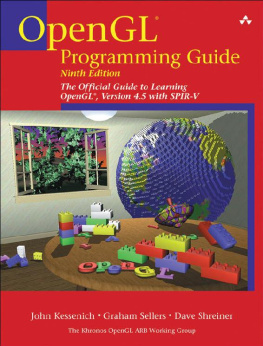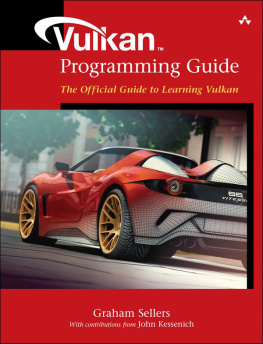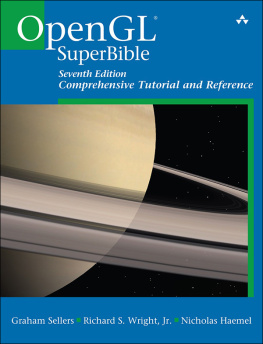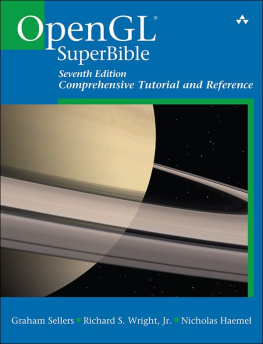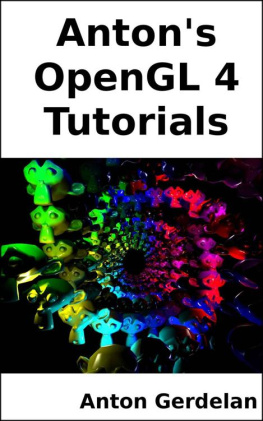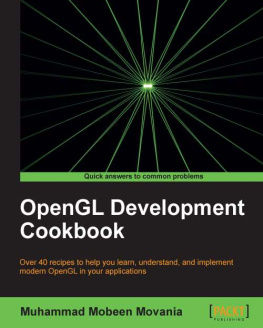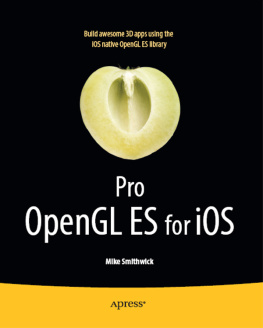John Kessenich - OpenGL Programming Guide: The Official Guide to Learning OpenGL, Version 4.5 with SPIR-V
Here you can read online John Kessenich - OpenGL Programming Guide: The Official Guide to Learning OpenGL, Version 4.5 with SPIR-V full text of the book (entire story) in english for free. Download pdf and epub, get meaning, cover and reviews about this ebook. year: 2016, publisher: Addison-Wesley, genre: Computer / Science. Description of the work, (preface) as well as reviews are available. Best literature library LitArk.com created for fans of good reading and offers a wide selection of genres:
Romance novel
Science fiction
Adventure
Detective
Science
History
Home and family
Prose
Art
Politics
Computer
Non-fiction
Religion
Business
Children
Humor
Choose a favorite category and find really read worthwhile books. Enjoy immersion in the world of imagination, feel the emotions of the characters or learn something new for yourself, make an fascinating discovery.
- Book:OpenGL Programming Guide: The Official Guide to Learning OpenGL, Version 4.5 with SPIR-V
- Author:
- Publisher:Addison-Wesley
- Genre:
- Year:2016
- Rating:3 / 5
- Favourites:Add to favourites
- Your mark:
OpenGL Programming Guide: The Official Guide to Learning OpenGL, Version 4.5 with SPIR-V: summary, description and annotation
We offer to read an annotation, description, summary or preface (depends on what the author of the book "OpenGL Programming Guide: The Official Guide to Learning OpenGL, Version 4.5 with SPIR-V" wrote himself). If you haven't found the necessary information about the book — write in the comments, we will try to find it.
Complete Coverage of OpenGL 4.5the Latest Version (Includes 4.5, 4.4, SPIR-V, and Extensions)
The latest version of todays leading worldwide standard for computer graphics, OpenGL 4.5 delivers significant improvements in application efficiency, flexibility, and performance. OpenGL 4.5 is an exceptionally mature and robust platform for programming high-quality computer-generated images and interactive applications using 2D and 3D objects, color images, and shaders.
OpenGL Programming Guide, Ninth Edition, presents definitive, comprehensive information on OpenGL 4.5, 4.4, SPIR-V, OpenGL extensions, and the OpenGL Shading Language. It will serve you for as long as you write or maintain OpenGL code.
This edition of the best-selling Red Book fully integrates shader techniques alongside classic, function-centric approaches, and contains extensive code examples that demonstrate modern techniques. Starting with the fundamentals, its wide-ranging coverage includes drawing, color, pixels, fragments, transformations, textures, framebuffers, light and shadow, and memory techniques for advanced rendering and nongraphical applications. It also offers discussions of all shader stages, including thorough explorations of tessellation, geometric, and compute shaders.
New coverage in this edition includes
- Thorough coverage of OpenGL 4.5 Direct State Access (DSA), which overhauls the OpenGL programming model and how applications access objects
- Deeper discussions and more examples of shader functionality and GPU processing, reflecting industry trends to move functionality onto graphics processors
- Demonstrations and examples of key features based on community feedback and suggestions
- Updated appendixes covering the latest OpenGL libraries, related APIs, functions, variables, formats, and debugging and profiling techniques
John Kessenich: author's other books
Who wrote OpenGL Programming Guide: The Official Guide to Learning OpenGL, Version 4.5 with SPIR-V? Find out the surname, the name of the author of the book and a list of all author's works by series.

